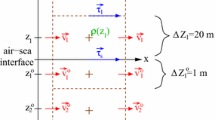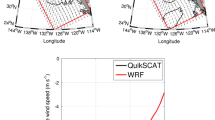Abstract
Observational studies have shown that mesoscale variations in sea surface temperature may induce mesoscale variations in wind. In eastern subtropical upwelling regions such as the California coast, this mechanism could be of great importance for the mean state and variability of the climate system. In coastal regions orography also creates mesoscale variations in wind, and the orographic effect may extend more than 100 km offshore. The respective roles of SST/wind links and coastal orography in shaping mesoscale wind variations in nearshore regions is not clear. We address this question in the context of the California Upwelling System, using a high-resolution regional numerical modeling system coupling the WRF atmospheric model to the ROMS oceanic model, as well as additional uncoupled experiments to quantify and separate the effects of SST/wind links and coastal orography on mesoscale wind variations. After taking into account potential biases in the representation of the strength of SST/wind links by the model, our results suggest that the magnitude of mesoscale wind variations arising from the orographic effects is roughly twice that of wind variations associated with mesoscale SST anomalies. This indicates that even in this region where coastal orography is complex and leaves a strong imprint on coastal winds, the role of SST/winds links in shaping coastal circulation and climate cannot be neglected.










Similar content being viewed by others
References
Blanke R, Roy C, Penven P, Speich S, McWilliams JC, Nelson G (2002) Linking wind and interannual upwelling variability in a regional model of the southern Benguela. Geophys Res Lett 29(24):2188. doi:10.1029/2002GL015718
Bryan FO, Tomas R, Dennis JM, Chelton DB, Loeb NG, McClean JL (2010) Frontal scale airsea interaction in high-resolution coupled climate models. J Clim 23(23):6277–6291
Capet XJ, Mmarchesiello P, McWilliams JC (2004) Upwelling response to coastal wind profiles. Geophys Res Lett 32:L13311. doi:10.1029/2004GL020123
Capet X, Colas F, Penven P, Marchesiello P, McWilliams J (2008) Eddies in eastern-boundary subtropical upwelling systems. In: Hecht M, Hasumi H (eds) Eddy-resolving ocean modeling. AGU Monograph, vol 177, Washington, p 350
Carton JA, Giese BS (2008) A reanalysis of ocean climate using simple ocean data assimilation (SODA). Mon Weather Rev 136:2999–3017
Chelton DB (2005) The impact of SST specification on ECMWF surface wind stress fields in the eastern tropical Pacific. J Clim 18:530–550
Chelton DB, Freilich MH (2005) Scatterometer-based assessment of 10-m wind analyses from the operational ECMWF and NCEP numerical weather prediction models. Mon Weather Rev 133:409–429
Chelton DB, Wentz FJ (2005) Global microwave satellite observations of sea surface temperature for numerical weather prediction and climate research. Bull Am Meteorol Soc 86:10971115
Chelton DB, Schlax MG, Freilich MH, Milliff RF (2004) Satellite measurements reveal persistent small-scale features in ocean winds. Science 303:978–983
Chelton DB, Michael GS, Roger MS (2007) Summertime coupling between sea surface temperature and wind stress in the california current system. J Phys Oceanogr 37(3):495–517
Chen F, Dudhia J (2001) Coupling an advanced land-surface/hydrology model with the Penn State/NCAR MM5 modeling system. Part I: model description and implementation. Mon Weather Rev 129:569–585
Colas F, Capet X, McWilliams JC, Shchepetkin A (2008) 19971998 El Niño off Peru: a numerical study. Prog Oceanogr 79:138–155
Dudhia J (1989) Numerical study of convection observed during the winter monsoon experiment using a mesoscale two-dimensional model. J Atmos Sci 46:3077–3107
Edwards KA, Rogers DP, Dorman CE (2002) Adjustment of the marine atmospheric boundary layer to the large-scale bend in the California coast. J Geophys Res 107:3213. doi:10.1029/2001JC000807
Enriquez AG, Friehe CA (1995) Effects of wind stress and wind stress curl variability on coastal upwelling. J Phys Oceanogr 25:1651–1671
Haack T, Chelton D, Pullen J, Doyle JD, Schlax M (2008) Air-sea interaction from US west coast summertime forecasts. J Phys Oceanogr 38:2414–2437
Hong SY, Noh Y, Dudhia J (2006) A new vertical diffusion package with an explicit treatment of entrainment processes. Mon Weather Rev 134:2318–2341
Jin X, Dong C, Kurian J, McWilliams JC, Chelton DB, Li Z (2009) SST/wind interaction in coastal upwelling: oceanic simulation with empirical coupling. J Phys Oceanogr 39(11):2957–2970
Jury MR, Walker N (1988) Marine boundary layer modification across the edge of the Agulhas Current. J Geophys Res 93:647–654
Koracin D, Dorman CE (2001) Marine atmospheric boundary layer divergence and clouds along California in June 1996. Mon Weather Rev 129:2040–2055
Maloney ED, Chelton DB (2006) An assessment of the sea surface temperature influence on surface wind stress in numerical weather prediction and climate models. J Clim 19(12):2743–2762
Marchesiello P, McWilliams JC, Shchepetkin A (2003) Equilibrium structure and dynamics of the California current system. J Phys Oceanogr 33:753–783
Mason E, Molemaker J, Colas F, Shchepetkin A, McWilliams JC, Sangra P (2009) Procedures for offline grid nesting in regional ocean models. Ocean Model (submitted)
Mesinger F, Dimego G, Kalnay E, Mitchell K, Shafran PC, Ebisuzaki W, Jovic D, Woollen J, Rogers E, Berbery EH, Ek MB, Yun F, Grumbine R, Higgins W, Hong Li, Ying L, Manikin G, Parrish D, Wei S (2006) A long-term, consistent, high-resolution climate dataset for the North American domain, as a major improvement upon the earlier global reanalysis datasets in both resolution and accuracy, is presented. Bull Am Meteorol Soc 87(3):342–360
Mlawer E, Taubman S, Brown P, Lacono M, Clough S (1997) Radiative transfer for inhomogeneous atmosphere: RRTM, a validated correlated-k model for the longwave. J Geophys Res 102:16663–16682
O’Neill LW, Chelton DB, Esbensen SK, Wentz FJ (2005) High-resolution satellite observations of SST modification of the marine atmospheric boundary layer over the Agulhas Return Current. J Clim 18:2706–2723
O’Neill LW, Chelton DB, Esbensen SK (2010) The effects of SST-induced surface wind speed and direction gradients on midlatitude surface vorticity and divergence. J Clim 23(2):255–281
Perlin N, Skyllingstad ED, Samelson RM, Barbour PL (2007) Numerical simulation of air-sea coupling during coastal upwelling. J Phys Oceanogr 37:2081–2093
Perlin N, Skyllingstad ED, Samelson RM (in press) Coastal atmospheric circulation around an idealized cape during wind-driven upwelling studied from a coupled ocean-atmosphere model. Mon Weather Rev
Samelson RM, Skyllingstad ED, Chelton DB, Esbensen SK, ONeill LW, Thum N (2006) On the coupling of wind stress and sea surface temperature. J Clim 19:1557–1566
Seo H, Miller AJ, Road JO (2007) The Scripps coupled ocean atmosphere regional (SCOAR) model, with applications in the eastern Pacific sector. J Clim 20:381–402
Shchepetkin AF, McWilliams JC (2005) The regional oceanic modeling system (ROMS): a split-explicit, free-surface, topography-following-coordinate oceanic model. Ocean Model 9:347–404
Shchepetkin AF, McWilliams JC (2009) Correction and commentary for “Ocean forecasting in terrain-following coordinates: formulation and skill assessment of the Regional Ocean Modeling System” by Haidvogel et al. J Comp Phys 227:3595–3624
Skamarock WC, Klemp JB, Dudhia J, Gill DO, Barker DM, Wang W, Powers JG (2007) A description of the advanced research WRF version 2. NCAR/TN-468+STR. NCAR technical note, 88 pp
Small RJ, Xie S-P, Wang Y, Esbensen SK, Vickers D (2005) Numerical simulation of boundary layer structure and cross-equatorial flow in the eastern Pacific. J Atmos Sci 62:1812–1830
Small RJ, deSzoeke SP, Xie SP, O’Neill L, Seo H, Song Q, Cornillon P, Spall M, Minobe S (2008) Air-sea interaction over ocean fronts and eddies. Dyn Atmos Oceans 45(3–4):274–319
Song Q, Chelton DB, Esbensen SK, Thum N, ONeil LW (2009) Coupling between sea-surface temperature and and low-level winds in mesoscale numerical models. J Clim 22(1):146–164
Spall M (2007) Midlatitude wind stress-sea surface temperature coupling in the vicinity of oceanic fronts. J Clim 20:3785–3801
Sweet WR, Fett R, Kerling J, La Violette P (1981) Airsea interaction effects in the lower troposphere across the north wall of the Gulf Stream. Mon Weather Rev 109:1042–1052
Wallace JM, Mitchell TP, Deser C (1989) The influence of sea surface temperature on surface wind in the eastern equatorial Pacific: seasonal and interannual variability. J Clim 2(12):1500–1506
Walton CC, Pichel WG, Sapper JF (1998) The development and operational application of nonlinear algorithms for the measurement of sea surface temperatures with the NOAA polar-orbiting environmental satellites. J Geophys Res 103(C12):27999–28012
Winant CD, Beardsley R, Dorman C, Friehe C (1988) The marine layer off northern California: an example of supercritical channel flow. J Atmos Sci 45:35883605
Xie SP (2004) Satellite observations of cool ocean-atmosphere interaction. Bull Am Meteorol Soc 85:195–208
Acknowledgments
This work was supported by the US National Science Foundation (NSF 0747533). Opinions, findings, conclusions, or recommendations expressed here are those of the authors and do not necessarily reflect NSF views. This research was supported in part by the National Science Foundation through TeraGrid resources provided by the Pittsburgh Supercomputing Center. We acknowledge the WRF and ROMS development groups and Hartmut Frenzel who helped with the implementation of the coupled model. NARR data from the US National Centers for Environmental Prediction were provided by the Data Support Section of the Computational and Information Systems Laboratory at the National Center for Atmospheric Research. NCAR is supported by grants from the National Science Foundation. QuikSCAT data are produced by Remote Sensing Systems and sponsored by the NASA Ocean Vector Winds Science Team. AMSR-E data are produced by Remote Sensing Systems and sponsored by the NASA Earth Science MEaSUREs DISCOVER Project and the AMSR-E Science Team. Data are available at http://www.remss.com. The MODIS SST data were obtained from the Physical Oceanography Distributed Active Archive Center (PO.DAAC) at the NASA Jet Propulsion Laboratory, Pasadena, CA. http://www.podaac.jpl.nasa.gov.
Author information
Authors and Affiliations
Corresponding author
Rights and permissions
About this article
Cite this article
Boé, J., Hall, A., Colas, F. et al. What shapes mesoscale wind anomalies in coastal upwelling zones?. Clim Dyn 36, 2037–2049 (2011). https://doi.org/10.1007/s00382-011-1058-5
Received:
Accepted:
Published:
Issue Date:
DOI: https://doi.org/10.1007/s00382-011-1058-5




